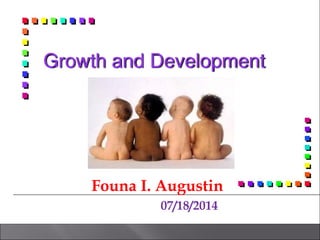
GROWTH AND DEVELOPMENT OF CHILDREN
- 4. Infancy is a time of intense growth and development. Both physical growth and acquisition of new motor skills slow somewhat during the toddler years. Refinement of motor skills, continued cognitive growth, and acquisition of appropriate language skills are of prime importance during the toddler years.
- 5. The first year of an infant’s life is both fascinating and startling. At six to ten days, the newborn can recognize the mother by smell. Babies at two weeks will look at their own mothers more frequently than they look at strangers. As they grow during their first year of life, their body language, intelligence, and social interaction also increase.
- 7. The word fontanel comes from the French fontaine for fountain. The medical term fontanel is a "soft spot" of the skull. The "soft spot" is soft precisely because the cartilage there has not yet hardened into bone between the skull bones. There are normally two fontanels, both in the midline of the skull, one (the anterior fontanel) well in front of the other (the posterior fontanel). The posterior fontanel closes first, at latest by the age of 8 weeks in a full-term baby. The anterior fontanel closes at 18 months of age on the average but it can close normally as early as 9 months. If fontanels close too early or too late, that may be a sign of a problem.
- 8. The major part of the infant’s first year is devoted to survival. The infant is completely helpless at birth and is totally dependent upon the parents for help. Being fed Held Touched Looked at And talked to These things have significant impact on the growth of the child. The average baby sleeps from 16-20 hours each day
- 12. By the end of the first year, the average one- year old is between 27 to 29 inches in height and weighs approximately 22 pounds. By the end of the third year, height has increased to around 36 inches and weight to 35 pounds. In the second and third years, growth is slower than infancy. However, it still occurs at a rapid place.
- 24. Physical and intellectual development are closely related to one another. The child learns about the world through exploration of objects, by moving around, and through interactions with the parents. The behavior of infants during the first year, and subsequent years, is to help them understand, adapt, and interact effectively with their world.
- 25. Reflex behaviors, like sucking are practiced (0-2 months) Recognizing familiar voices and faces (2 months) Responds to strangers by crying or staring (2 months) Like repetition of simple acts like sucking, open and closing hands, etc. for sake of activity (2-3 months) Baby still cries but also laughs out loud (4 months) Can imitate sounds; watches your mouth with interest when talking (7 months) Responds to and imitates facial expressions of others (5-12 months) Child uses responses to solve problems and to achieve some goals. Example, move one object to get another one (12 months)
- 28. Language develops very slowly during the first of life. At birth babies cannot say anything. By the end of their first year, their vocabulary increases to about two to eight words. The first two years are the most important Parents who talk to their babies, praise and reinforce their efforts at communication help facilitate the development of language.
- 29. First they CRY Crying is a way babies let their parents know that they are wet, hungry, tired, or frightened. By the second month, babies begin cooing, a way of showing their pleasure. Babbling begins during the fourth or fifth months. Syllables are repeated over and over again.
- 32. According to Erik Erickson, from birth to one year, the child struggles with learning to trust or mistrust himself and others in others in his environment. The quality of the care the child receives creates a great impact to the degree to which that child come to trust the environment, himself and other people. The child who receives inconsistent, inadequate care and who is rejected develop a basic mistrust. For this child, the world is not a safe, fun place to be and people are not to be depended upon to have needs met. Therefore,
- 34. Overall, understanding the stages of growth and development in children is critical in providing an environment that fosters success and pride in accomplishments. Self-worth is established very early in a child’s life as they learn they are either successful or not pleasing their parents. When parents are pleased, children begin to feel successful. When parents are not pleased, children begin to feel like failures. Growth and development is like a spiral going upward from a limited set of skills to more and more advanced skills, as children get older.
- 35. http://www.medterms.com/script/main/art. asp?articlekey=3498 Stephen J. Bavolek, Ph.D. Nurturing Parenting for Parents of Infants, Toddlers and Preschoolers Copyright 2007 by Family Development Resources, Inc.